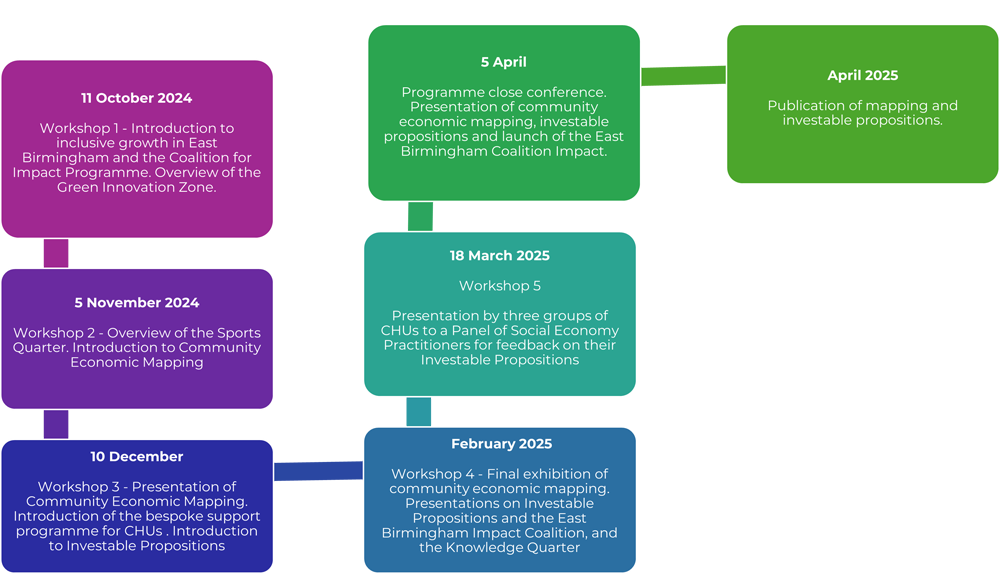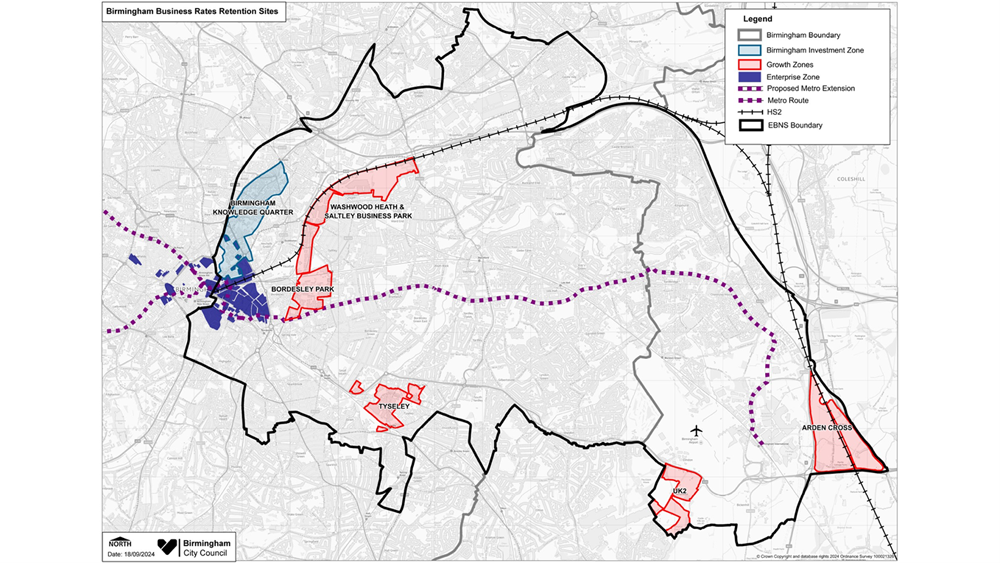The Coalition for Impact programme is a project that is bringing 13 community hub organisations into the heart of the development of an ambitious growth programme in East Birmingham, which has the highest level of deprivation in Birmingham with nearly 150,000 people living in the most deprived decile as recorded by the Index of Multiple Deprivation. At the same time there are tremendous opportunities to draw down resources to fund local growth with three new Zone designations that are key elements of the regional growth agenda:
The WMCA Devolution deal recognised EBNS as a Levelling Up Zone a priority area for regeneration which is expected to benefit from prioritised access to funding via the WMCA Single Settlement. It is also a vehicle for close collaboration with Solihull MBC, WMCA and national Government around economic growth and service improvement.
The delivery of EBNS will be supported by the EBNS Growth Zone - a fiscal designation which provides the Council with Business Rate Retention for 25 years across an area of 183 ha in Birmingham. The growth in Business Rates (uplift) within this area will be available to use for investment or to enable borrowing at the Council’s discretion.
The Birmingham element of the WMCA Investment Zone (Birmingham Knowledge Quarter/BKQ) is also located within EBNS. It includes three key elements:
- Tax relief sites – a cluster of plots have been identified at BKQ with a 5-year package of tax relief fully funded by Government
- Flexible Funding access – a total of £160m is available to WMCA for the delivery of the IZ over ten years
- Business Rate Retention – for 25 years across an area of 135 ha. The uplift from this area will be used by WMCA and BCC to deliver the Investment Zone, with the BKQ site being the initial investment priority for uplift collected by Birmingham Council.
Funded through UK Government’s Shared Prosperity Fund, the programme is exploring, through a collaborative learning approach, how community organisations can play a more active role in shaping growth by securing better access to employment opportunities and ensuring that investment in community infrastructure, amenities and services. This has seen real progress on-the-ground local projects and partnership-building have addressed urgent need and boosted capacity in the community to take a leading role in the regeneration of their areas. This has seen 12 projects currently in delivery, with a further ten projects in development and work delivered across 12 workstreams and 15 strategic partnerships, green infrastructure improved (including new pocket parks and River Cole valley), 1,000+ people from the local communities engaged directly in projects and local events/activities, 35+ grants awarded to community organisations, over 400 local businesses engaged and over 50 supported to date including access to finance, access to innovation ecosystem and support towards the net zero transition, one social economy cluster and one local enterprise hub supported. Coalition for Impact is a great example of one of these localised projects.
The model of ‘Inclusive growth’ is an attempt to address this, by recognising that whilst economic growth is desirable, growth which isn’t well shared across society is unfair and divisive. The West Midlands Combined Authority defines ‘Inclusive Growth’ as “a more deliberate and socially purposeful model of economic growth - measured not only by how fast or aggressive it is; but also, by how well it is created and shared across the whole population and place, and by the social and environmental outcomes it realises for our people.”
Nine community hub organisations were grant aided to participate in a collaborative learning plan exploring how a community economic regeneration approach by bridging micro assets (9 community hub organisations) and macro assets (3 growth zones in East Birmingham) can ensure that growth (typically seen as increased GDP) can deliver wider social and economic benefits.

The diagram above shows how micro and macro assets can be connected by ‘bridging’ to create inclusive growth that grows the economy through traditional metrics such as GDP alongside more localised metrics such as the growth in local skills, numbers of community businesses and local employment.
There are four strands to the project:
- Community economic mapping & developing Investable Propositions
- Bespoke support for participating community organisations
- Inquiry into a women's led economy in East Birmingham
- Social Research into the role of capacity building of community hub organisations in inclusive growth
Strand 1 - Community economic mapping & developing Investable Propositions
This strand allocated nine community hub organisations (CHOs) to three identified growth zones (see appendix 1) in East Birmingham based on their connection to each in terms of place and their delivery focus.
All nine CHOs have engaged in a series of collaborative learning workshops where they could work as a single cohort of 9 and share their experiences of working as a group of three organisations in each zone as well as independently in their own neighbourhoods with their own social networks.
These have included:

In addition to participating in the collaborative learning, the nine CHOs have held community meetings in two phases to engage with their residents, stakeholders and networks. In the first phase, the meetings in the autumn of 2024 focussed on community economic mapping enabling local stakeholders to guide the mapping process which informed the final production of maps with each CHO producing three maps for their area delineating their social, economic and neighbourhood geographies with a summary narrative.
Each of these for the final conference will be stitched together to form a unified set of maps for each cluster. In the second set of community meetings held in spring 2025, each CHO engaged their networks on the development of their Investable Propositions and then presented these in a bespoke workshop with a panel of expert practitioners in the field of social economy. Out of this, the CHOs in each quarter, supported by the panel and Loconomy associates, explored the synergies and alignment between the different Investable Propositions.
Strand 2 – Bespoke support for participating community hub organisations
Each CHO was able to access a support programme delivered by Cooperative Futures (see PowerPoint slides) through additional workshops as well as 121 supports on community assets. These included:
- Community assets
- Community investment
- Community governance
- Community business planning
- Community funding and investment
Strand 3 – Inquiry into a women’s led economy in East Birmingham
Four CHOs who engaged in the Ready2Level programme, a precursor to Coalition for Impact where 10 CHOs participated in an appreciative inquiry to produce a local action plan, secured funding to lead an inquiry into how a women’s led economy can play a part in boosting inclusive growth. These included:
- Go-Woman Alliance CIC
- Grand Union
- Arts in the Yard
- Open Door Community Foundation
The CHOs self-directed their inquiry and will produce a report with recommendations on their findings. They also undertook community mapping using the broader geography of East Birmingham and looking at the geographies within through a women’s lens. They will also be producing an Investable Proposition around a Women’s Economy hub.
Strand 4 – Social research into the role of capacity building
Loconomy were commissioned to undertake social research on the importance of capacity building in the field of inclusive growth. Our senior associate, Ian Dudfield, who leads our social research work undertook field work during the programme capturing the views of CHO practitioners as well as some of their stakeholders. The report will make recommendations on how CHOs can be empowered and enabled to play a sustained role in the evolution of the East Birmingham Inclusive Growth Strategy. The report will be published on 5th April and launched at the end of the programme conference.

